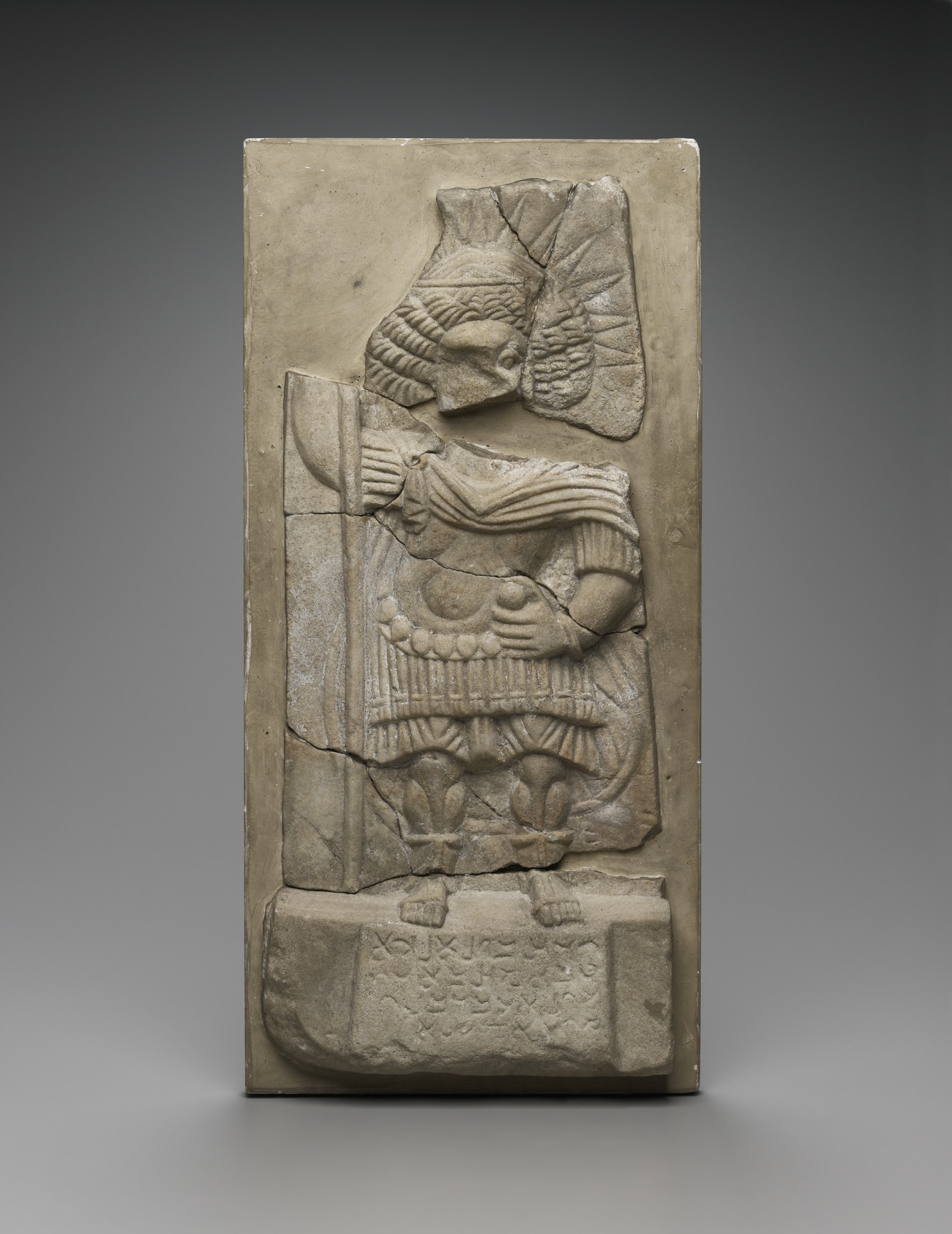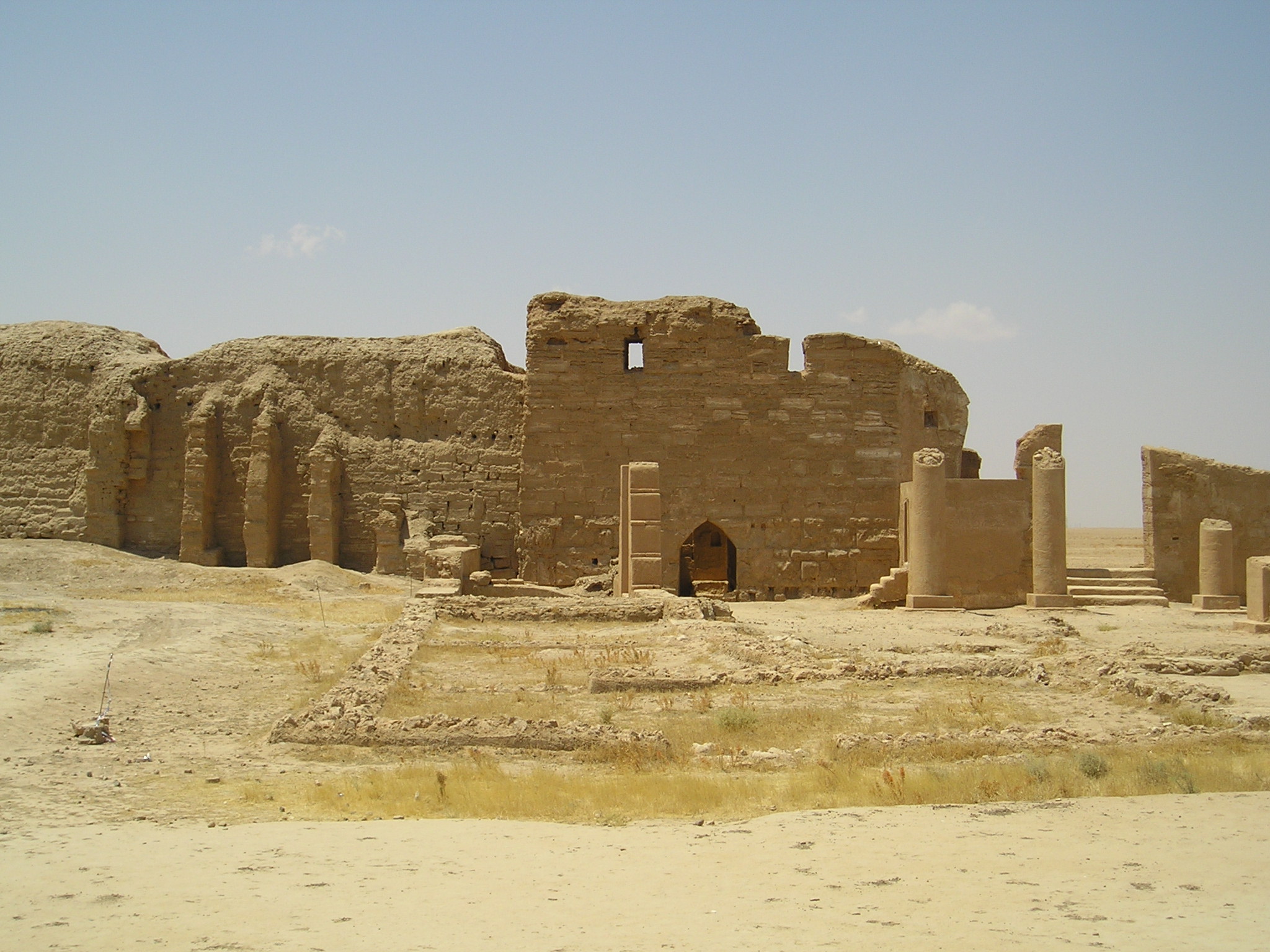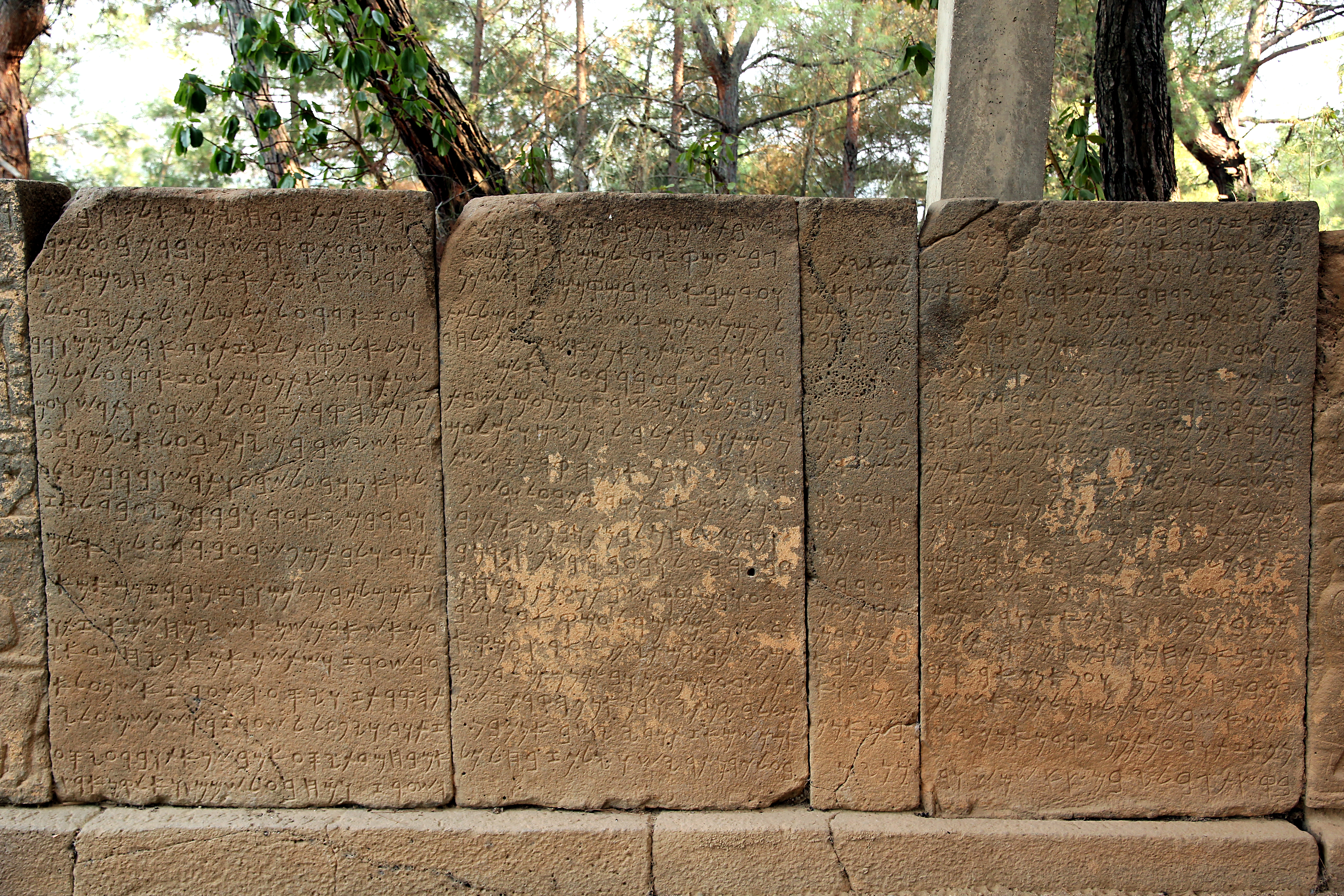|
Yarhibol
Yarhibol or Iarhibol is an Aramean god who was worshiped mainly in ancient Palmyra, a city in central Syria. He was depicted with a solar nimbus and styled "lord of the spring". He normally appears alongside Bel, who was a co-supreme god of Palmyra, and Aglibol, one of the other top Palmyrene gods. Origins It is believed that Yarhibol was originally the patronus/ genius loci of the source Efqa in Palmyra; it is known that his title was "Lord / Guardian adof the Source". In general, however, his onomastics indicates an earlier connection with the lunar, not the solar, cult. His name translates as "the moon of Bel", and at the same time shows a connection with the North-Western Semitic ( Canaanite) moon god Jarih (Yariḫ). It is characteristic that on the stele in Dura Europos (2nd century AD), apart from the radiant crown, it is additionally decorated with a crescent. Earlier Yarhibol must have been a local deity of ancestors in a desert oasis, worshiped by the descendants of ... [...More Info...] [...Related Items...] OR: [Wikipedia] [Google] [Baidu] |
Dura Europos
Dura-Europos, ; la, Dūra Eurōpus, ( el, Δούρα Ευρωπός, Doúra Evropós, ) was a Hellenistic, Parthian, and Roman border city built on an escarpment above the southwestern bank of the Euphrates river. It is located near the village of Salhiyé, in present-day Syria. Dura-Europos was founded around 300 BC by Seleucus I Nicator, who founded the Seleucid Empire as one of the Diadochi of Alexander the Great. In 113 BC, Parthians conquered the city, and held it, with one brief Roman intermission (114 AD), until 165 AD. Under Parthian rule, it became an important provincial administrative centre. The Romans decisively captured Dura-Europos in 165 AD and greatly enlarged it as their easternmost stronghold in Mesopotamia, until it was captured by the Sasanian Empire after a siege in 256–57 AD. Its population was deported, and the abandoned city eventually became covered by sand and mud and disappeared from sight. Dura-Europos is of extreme archaeological importance, ... [...More Info...] [...Related Items...] OR: [Wikipedia] [Google] [Baidu] |
Palmyra
Palmyra (; Palmyrene: () ''Tadmor''; ar, تَدْمُر ''Tadmur'') is an ancient city in present-day Homs Governorate, Syria. Archaeological finds date back to the Neolithic period, and documents first mention the city in the early second millennium BC. Palmyra changed hands on a number of occasions between different empires before becoming a subject of the Roman Empire in the first century AD. The city grew wealthy from trade caravans; the Palmyrenes became renowned as merchants who established colonies along the Silk Road and operated throughout the Roman Empire. Palmyra's wealth enabled the construction of monumental projects, such as the Great Colonnade, the Temple of Bel, and the distinctive tower tombs. Ethnically, the Palmyrenes combined elements of Amorites, Arameans, and Arabs. The city's social structure was tribal, and its inhabitants spoke Palmyrene Aramaic, a variety of Western Middle Aramaic, while using Koine Greek for commercial and diplomatic purposes. ... [...More Info...] [...Related Items...] OR: [Wikipedia] [Google] [Baidu] |
Bel (god)
Bêl (; from akk, bēlu) is a title signifying "lord" or "master" applied to various gods in the Mesopotamian religion of Akkad, Assyria, and Babylonia. The feminine form is ''Bêlit'' ('Lady, Mistress') in Akkadian. ''Bel'' is represented in Greek as Belos and in Latin as Belus. ''Belit'' appears in Greek form as Beltis (Βελτις). Linguistically, ''Bel'' is an East Semitic form cognate with the Northwest Semitic Baal with the same meaning. ''Bel'' was especially used for the Babylonian god Marduk in Assyrian and neo-Babylonian personal names or mentioned in inscriptions in a Mesopotamian context. Similarly, ''Bêlit'' mostly refers to Marduk's spouse Sarpanit. Marduk's mother, the Sumerian goddess often referred to in the Sumerian language as Ninhursag, Damkina, and Ninmah, was often known as ''Belit-ili'' ("Lady of the Gods") in Akkadian. Other gods called "Lord" were sometimes identified totally or in part with Bel Marduk. The god Malak-bel of Palmyra is an ex ... [...More Info...] [...Related Items...] OR: [Wikipedia] [Google] [Baidu] |
Bel (mythology)
Bêl (; from akk, bēlu) is a title signifying "lord" or "master" applied to various gods in the Mesopotamian religion of Akkad, Assyria, and Babylonia. The feminine form is ''Bêlit'' ('Lady, Mistress') in Akkadian. ''Bel'' is represented in Greek as Belos and in Latin as Belus. ''Belit'' appears in Greek form as Beltis (Βελτις). Linguistically, ''Bel'' is an East Semitic form cognate with the Northwest Semitic Baal with the same meaning. ''Bel'' was especially used for the Babylonian god Marduk in Assyrian and neo-Babylonian personal names or mentioned in inscriptions in a Mesopotamian context. Similarly, ''Bêlit'' mostly refers to Marduk's spouse Sarpanit. Marduk's mother, the Sumerian religion, Sumerian goddess often referred to in the Sumerian language as Ninhursag, Damgalnuna, Damkina, and Ninmah, was often known as ''Belit-ili'' ("Lady of the Gods") in Akkadian. Other gods called "Lord" were sometimes identified totally or in part with Bel Marduk. The god Malak-b ... [...More Info...] [...Related Items...] OR: [Wikipedia] [Google] [Baidu] |
Temple Of Bel, Dura-Europos
The Temple of Bel, also known as the Temple of the Palmyrene gods, was located in Dura Europos, an ancient city on the Euphrates, in modern Syria. The temple was established in the first century BC and is celebrated primarily for its wall paintings. Despite the modern names of the structure, it is uncertain which gods were worshipped in the structure. Under Roman rule, the temple was dedicated to the Emperor Alexander Severus. In that period, the temple was located within the military camp of the XXth Palmyrene cohort. Under Roman rule, the temple was dedicated to the Emperor Alexander Severus. In that period, the temple was located within the military camp of the XXth Palmyrene cohort. Discovery The temple's paintings were discovered in 1920 by M. C. Murphy. Photos of them reached James Henry Breasted, who studied both the paintings and the temple and would publish a monograph about them in 1924. Before Murphy's discovery, the site was unknown. Its identification with the tow ... [...More Info...] [...Related Items...] OR: [Wikipedia] [Google] [Baidu] |
Ancient Canaanite Religion
The Canaanite religion was the group of ancient Semitic religions practiced by the Canaanites living in the ancient Levant from at least the early Bronze Age through the first centuries AD. Canaanite religion was polytheistic and, in some cases, monolatristic. Beliefs Deities A group of deities in a four-tier hierarchy headed by El and Asherah were worshiped by the followers of the Canaanite religion; this is a detailed listing: * Aglibol, god of the moon and brother of Malakbel. Part of a trio of gods of Palmyra, Syria along with Bel and Yarhibol. Also part of another trio with Baalshamin and Malakbel. * Anat, virgin goddess of war and strife, sister and putative mate of Ba'al Hadad. * Arsay, goddess of the underworld, one of the three daughters of Ba'al Hadad. * Arsu, god of the evening star and twin brother of Azizos. * Ashtar-Chemosh, wife of Chemosh and goddess of the Moabites. * Asherah, queen consort of El (Ugaritic religion), Elkunirsa (Hittite religion), Yahwe ... [...More Info...] [...Related Items...] OR: [Wikipedia] [Google] [Baidu] |
Malakbel
Malakbel (Arabic: ملاك بعل) was a sun god worshiped in the ancient Syrian city of Palmyra, frequently associated and worshiped with the moon god Aglibol as a party of a trinity involving the sky god Baalshamin. Etymology Malakbel's name means "Angel of Bel", attesting to his mythological role as Bel's messenger and acolyte. Archaeological evidence The earliest known mention of Malakbel was an inscription which dates back to 17 BC and associates him with the lunar god Aglibol. Several other inscriptions made by the Bene Komare also associate him with Aglibol, including a bilingual inscription from 122 AD in which Aglibol and Malakbel sponsor a citizen by the name of Manai for his piety. Attestations of Malakbel's worship can be found in Rome, and as far as the province of Numidia in north Africa, as attested by a circa 178 AD inscription in the town of El Kantara, where Palmyrene archers were stationed. Sanctuaries In Palmyra Several 2nd century AD inscriptions from ... [...More Info...] [...Related Items...] OR: [Wikipedia] [Google] [Baidu] |
Jarih
Yarikh (Ugaritic: , , "moon") was a moon god worshiped in the Ancient Near East. He is best attested in sources from the Amorite city of Ugarit in the north of modern Syria, where he was one of the principal deities. His primary cult center was most likely Larugadu, located further east in the proximity of Ebla. He is also attested in other areas inhabited by Amorites, for example in Mari, but also in Mesopotamia as far east as Eshnunna. In the Ugaritic texts, Yarikh appears both in strictly religious context, in rituals and offering lists, and in narrative compositions. He is the main character in ''The Marriage of Nikkal and Yarikh'', a myth possibly based on an earlier Hurrian composition. The eponymous goddess was regarded as his wife in Ugarit, but she is not attested in documents from most other Syrian cities, and most likely only entered the Ugaritic pantheon due to the influence of Hurrian religion. Ugarit ceased to exist during the Bronze Age collapse, and while Yarikh co ... [...More Info...] [...Related Items...] OR: [Wikipedia] [Google] [Baidu] |
Temple Of Artemis Azzanathkona
The temple of Artemis Azzanathkona is located in Dura Europos in the east of present-day Syria, and was dedicated to a syncretic belief of Artemis and Azzanathkona. In Roman times the temple became a headquarters for the Cohors XX Palmyrenorum, a infantry and cavalry unit. A military archive of the Cohors was found in one of the temple rooms. The archive consists of numerous papyri and parchments; it is one the most important finds that shed light on the organization of Roman military units. The temple complex was excavated in 1931–32. Smaller follow-up examinations took place between 2007 and 2010. Description The temple was built against the north wall near the Temple of Bel. The earliest inscriptions is dated as 12/13 AD. The temple and the next building weren't in a good state when found, so its hard to know how they were related. The temple had an almost square precinct surrounded by rooms built at different periods; it had two sanctuary units, both dated approximatel ... [...More Info...] [...Related Items...] OR: [Wikipedia] [Google] [Baidu] |
Aglibol
Aglibol is a god from Palmyra, originating from a north Syrian immigrant community. He is a moon god who was worshiped in the ancient Syrian city of Palmyra as part of a trinity alongside Bel and Yarhibol, and associated with the sun god Malakbel. Evidence of Aglibol's worship is primarily epigraphical. The earliest known mention of Aglibol was an inscription which dates back to 17 BCE and associates him with the sun god Malakbel. Several other inscriptions made by the Bene Komare also associate him with Malakbel, including a bilingual inscription from 122 CE in which Aglibol and Malakbel sponsor a citizen by the name of Manai for his piety. Several second century CE inscriptions attest that Aglibol was venerated with Malakbel in a sanctuary known as the "Sacred Garden" (gnt' 'ilym), which was one of the four principal sanctuaries of the city. The Bene Komare tended to this sanctuary. The sanctuary had two altars, a sacred cypress and a bath. One of the reliefs found in the Temp ... [...More Info...] [...Related Items...] OR: [Wikipedia] [Google] [Baidu] |
Venus (goddess)
Venus (), , is a Roman goddess, whose functions encompass love, beauty, desire, sex, fertility, prosperity, and victory. In Roman mythology, she was the ancestor of the Roman people through her son, Aeneas, who survived the fall of Troy and fled to Italy. Julius Caesar claimed her as his ancestor. Venus was central to many religious festivals, and was revered in Roman religion under numerous cult titles. The Romans adapted the myths and iconography of her Greek counterpart Aphrodite for Roman art and Latin literature. In the later classical tradition of the West, Venus became one of the most widely referenced deities of Greco-Roman mythology as the embodiment of love and sexuality. She is usually depicted nude in paintings. Etymology The Latin theonym ''Venus'' and the common noun ''venus'' ('love, charm') stem from a Proto-Italic form reconstructed as ''*wenos-'' ('desire'), itself from Proto-Indo-European (PIE) ' ('desire'; cf. Messapic ''Venas'', Old Indic ''vánas'' 'des ... [...More Info...] [...Related Items...] OR: [Wikipedia] [Google] [Baidu] |
Almaqah
Almaqah or Almuqh ( xsa, 𐩱𐩡𐩣𐩤𐩠; ar, المقه; gez, አልመቀህ) was the Moon god of the ancient Yemeni kingdom of Saba'. He was also worshipped in the kingdom of Dʿmt, which later became the kingdom of Aksum in Ethiopia and Eritrea. Characteristics Jacques Ryckmans states, The ruling dynasty of Saba' regarded themselves as his seed. Almaqah is represented on monuments by a cluster of lightning bolts surrounding a curved, sickle-like weapon. Bulls were sacred to him. Temples Both the Barran Temple and the Awwam temple were dedicated to Almaqah. See also *Ancient history of Yemen The ancient history of Yemen ( South Arabia) is especially important because Yemen is one of the oldest centers of civilization in the Near East. Its relatively fertile land and adequate rainfall in a moister climate helped sustain a stable pop ... References External links * Arabian gods Lunar gods Sabaeans {{MEast-myth-stub ... [...More Info...] [...Related Items...] OR: [Wikipedia] [Google] [Baidu] |









